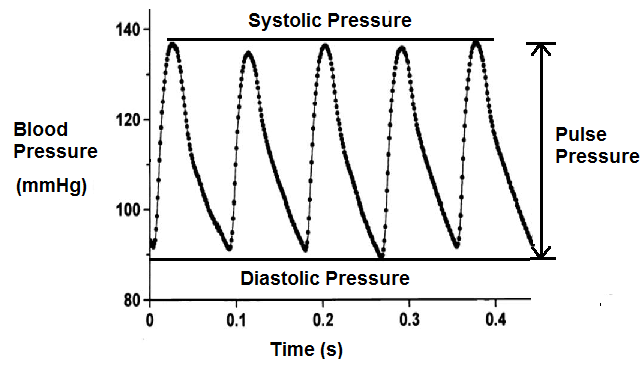Pulse Pressure Calculator

Pulse Pressure= Systolic Pressure - Diastolic Pressure

This pulse pressure calculator calculates the pulse pressure of a person.
Pulse pressure is the pressure that is felt when feeling the pulse. It is the difference between the maximum and minimum blood pressures produced during one heartbeat.
Pulse pressure is determined by 2 variables, the systolic pressure and the diastolic pressure.
The systolic pressure is the pressure which the heart produces during the systole cycle. Systole is the cycle in the cardiac process when the heart contracts. Therefore, during systole, the heart produces the greatest amount of pressure in order to pump blood. Therefore, the systolic pressure reading is always greater than the diastolic pressure reading. The unit of diastolic pressure is millimeters of mercury (mmHg).
The diastolic pressure is the pressure which the heart produces during the diastole cycle. Diastole is the cycle in the cardic process when the heart relaxes. Therefore, during diastole, the heart creates less pressure, because it is in relaxation. Therefore, the diastolic pressure reading is always less then the systolic pressure. The unit is also millimeters of mercury (mmHg).
The difference between the systolic pressure and the diastolic pressure is the pulse pressure, as shown in the formula seen above.
To use this calculator, a user just enters the 2 variables, the systolic pressure and the diastolic pressure and clicks the 'Calculate' button, and the resultant pulse pressure value will automatically be calculated. The unit of the pulse pressure is in millimeters of mercury (mmHg).
A typical systolic pressure of 120mmHg and a typical diastolic pressure of 80mmHg will produce a pulse pressure of 40mmHg, since 120mmHg - 80mmHg= 40mmHg.
Electronic devices such as pacemakers can influence the systolic and diastolic pressure, and, therefore, the
pulse pressure, because they can initiate as the pacemaker of the heart.
Example Calculation
If a person has a systolic pressure of 110mmHg and a diastolic pressure of 60mmHg, what is the pulse pressure of this individual?
So based on the values of the parameters, we use the equation PP= SP- DP and substitute in the values into the equation.
Pulse Pressure= 110mmHg-60mmHg= 50mmHg
Related Resources
Cardiac Output Calculator
Stroke Volume Calculator
Mean Arterial Pressure Calculator
ABCD2 Stroke Score Calculator
